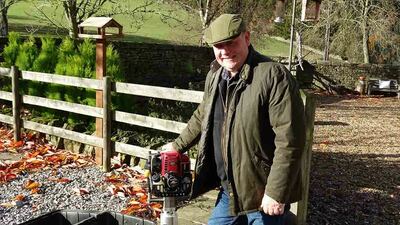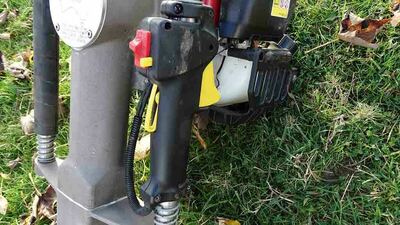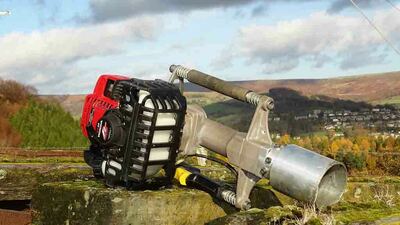
We catch up with one farmer who is saving the back-breaking work of fencing with an Australian-made petrol-powered post driver.
While the views in the Peak District may be some of the most beautiful in the UK, they come at a price.
For Derbyshire farmer John Wain, the banks and moorland on his farm are all but impossible to traverse with anything but a quad bike.
This becomes a more pressing issue when fence maintenance and erecting has to be done, as, until recently, a drive-all-style post driver and mallet were the only options.
However, in 2015, it was on a trip to Lamma where Mr Wain, of Highlow Farm, Hathersage, came across the Easy Petrol Post Driver.
He says: "The hills here are so steep, it is not safe to traverse them, even if ground conditions are right.
"Carefully picking a route, I can just about get the quad bike or UTV up, so I have to carry all the equipment, posts and wire on the load beds."
Coupled with this, large swaths of his farm is moorland that he says can soon start pulling machines into it.
Much of Mr Wain's fencing requirement involves adding topping wire to dry stone walls to contain the 600 ewes that stock his farm. The land is rented by a young shepherd who also has a shoot on the land, however, Mr Wain still carries out the maintenance on his 284-hectare unit.
Heavy
He notes that when replacing posts holding his topping wire in place, using a drive-all would snag on the wire, not to mention being very heavy and tiring to use.
He says: "Anyone who has knocked posts in with a drive-all knows it is very hard work and, to add to the challenge, our land is incredibly stony."
Mr Wain's answer came in the form of the petrol post driver designed and built by Australian company Christie. Doing the hard work of knocking the post in, the machine crucially only weighs about the same as a drive-all, at just over 15kg.
Capable of whacking in a four-inch round post, it is powered by a 1.3hp Honda GX35 four-stroke engine, delivering 1,720 blows per minute.
Importer Simon Anthony explains the machine is more than a motorised battering ram.
He says: "The 9.8 metres per second blows coming from the machine synchronise the post and ground to the same frequency, creating a liquid-like behaviour, easing the post into the ground."
This, he says, does not exert the same pressures on the post that are exerted with a tractor-mounted post knocker, making it safer for the operator, while preserving the quality of the post.
In Mr Wain's situation, there are a lot of sub-surface rocks which hamper progress. He uses a steel bar to pilot a hole for the post to go into.
In exceptional circumstances, he will also use a pilot core tool in conjunction with the petrol driver, that removes a 40mm core of soil and stone.
When soil is dry, this can also be filled with water to soften and ease friction in the area, making it easier to put the post in.
The pilot core tool has a heat-treated cutting head for durability. It is removed by inserting a bar through the top, then using a post as a lever to twist and pull the core tool out. He says it is quick and easy to use, stopping about 152mm (6in) above the required depth of the post, leaving some ground at the bottom to bite onto the post.
EASY PETROL POST DRIVER - THE IMPORTER
SIMON Anthony says he first saw the machine seven years ago, while running the family's contract landscaping business.
Fencing is a large part of its service portfolio, so naturally Mr Anthony says he was interested in learning more about it.
He contacted Australian manufacturer Christie, with suggestions to make the machine more appealing for the European market.
This included a range of adapter shapes and sizes, rather than the adapter for the picket-style fencing used in Australia. His company then started importing the machines into the UK and has since become the main dealer for the UK.
The machine comes as standard with a one-year warranty on the engine and three years for the rest of the machine. So far 25,000 machines have been sold worldwide.


































